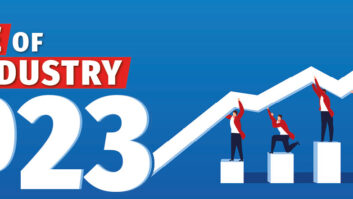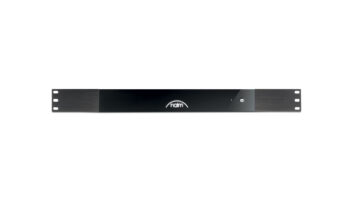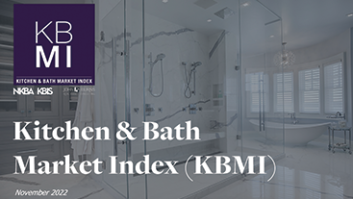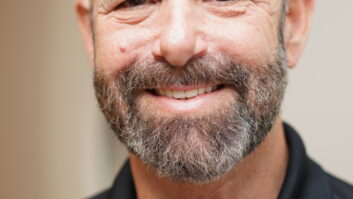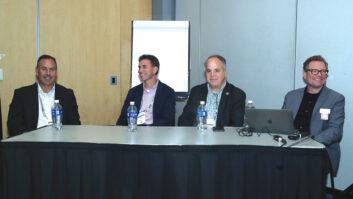Stop and think about this for a moment: How much better would your decisions be if you knew today where the industry was headed in the future? You’d make sure you were fully educated on the right technologies. You would efficiently spend your money on acquiring only the right tools and resources you needed. And you would partner with exactly the right people, organizations, and products to maximize the opportunity. If only you could know…
Residential Systems invited executives from a wide cross-section of the industry to tell us where we’re headed–not in February 2017, but in February 2022–five full years down the road.
We asked one simple question: What will the industry look like five years from now?
Here’s what they said (edited for space):

Martin Plaehn – Chairman and CEO, Control4
“When we look at the world [in five years], we see two big phenomena: one is…the connected home is going to happen… [There will be two versions:] the loosely coupled connected home–a bunch of devices on a network and a bunch of apps that do cool things for themselves. And the orchestrated connected home, where sets of devices, if not all of them, work together much like an orchestra does.
“Then there’s this network [the second phenomenon] that lies underneath it–that’s just got to get smarter and more capable… [Control4 is] investing hard in smarter and smarter networking, both from a wired, and a wireless standpoint, to handle all the different types of connected home traffic.
“[Beyond that, systems have] to be remotely managed and monitored, because most consumers aren’t going to do this themselves.”
Click here to read more from Plaehn’s extensive interview

Michael Smith – Vice-President of Sales, Lutron Electronics
“Lutron’s hope is that in the next five years we’re not talking about smart homes anymore; we’re just talking about ‘home,’ and that people are using technology in every room to live a richer life and simplify daily routines. To achieve that, we’ll see even more builders standardizing connected products in their communities, like what we’re seeing now with Lennar and KB Homes. Lutron is working with both builders to help homeowners live more connected lives through products like motion sensors, our Caseta Wireless connected lighting control system, and Serena automated shades.”

Vin Bruno – CEO, CEDIA
“Our industry is poised for exponential growth, and there is so much to be excited for. [There are] three areas that will become a much bigger [factor] for home technology professionals: artificial intelligence (AI), cybersecurity, and home health.
“AI has the ability to learn the habits and preferences of the occupants and make informed decisions on the backend so that the homeowner really does not need to interact with the electronics in the home nearly as often, and instead the home’s environment is more energy efficient, relaxing, fun, and safe.
“Last October’s DDoS attacks caused shockwaves… The next five years we’ll see manufacturers prioritizing security over convenience, and CEDIA members becoming the go-to experts for home cybersecurity.
[Finally] the number of residents 65 or older will grow… to nearly 73 million by 2030. The [NAHB] estimates that more than 70 percent of these homeowners are planning on making aging-related improvements for themselves or their parents.”

Randy Klein – President and CEO, Crestron Electronics
“We will be in business, bigger and better than we are today and those aren’t mutually exclusive terms–you have to be bigger and you have to be better. You can’t be one without the other. And I personally think this industry is absolutely positioned and poised to be exponentially bigger and better in five years because we’re at breakthrough stages right now.
“I think that in the high-end professional market, the trend is going to be the continuation and development of a single integrated, managed platform. Because that’s the only way–a high-end project can’t be a collection of disparate technologies or products that are pieced together. It’s not sustainable and it’s not scalable.”

Mark Schafle – CEO, James Loudspeaker
We anticipate that the number of players in the audio/video and consumer electronics industries will shrink as the product sophistication level increases and user interfaces become more intuitive. With growing business opportunities in these markets now drawing attention from the likes of Google, Apple, Sonos, and others, they will likely thin the herd amongst the automation and audio brands that can’t keep up.
“To date, nearly non-existent competition has provided many manufacturers the luxury of establishing talent-challenged businesses that bring little innovation to the party for the past 30 years. That will change as we now have a group of exceptional minds coming into our space, and that is going to completely alter the landscape as we know it.”

Jason Sloan – Chief Sales Officer, Dana Innovations/Sonance
“We are experiencing great convergence of technology from the DIY space to the CEDIA professional. The ‘gear’ has historically been the differentiating factor, but that is changing, rapidly. While DIY gear continues to improve, my belief is that the CEDIA professional servicing the one percent (or 0.5 of one percent) will continue to experience a robust customer base with the desire to have products installed for them.
“The wired and wireless infrastructure of a home or building many times defines the success of the technology implemented within. As the robustness of the network improves, any type of audio (high resolution music, Flac, DSD, etc.) and video (4K, 8K, 87K) content will be at anyone’s fingertips. With that, there will be a refocus on installing higher quality product and performance-based environments.
“These environments will look different than the past and will focus on the kitchen, living, outdoor, and other entertaining spaces (versus the dedicated rooms of years past).”

Frank K. Sterns – Vice President, Sony Electronics
“The first trend I feel pretty confident of is that our business– integrated systems–will be substantially bigger in five years than it is today. I hate to use the word ‘millennials,’ but you’ve got a large group of potential consumers…that five years from now will be at a point in their lifecycle where they are investing in homes and families. I think that’s going to drive a huge boom in connected home systems, entertainment, automation, etc.
“In product and technology, I see four things: 1) connected, 2) immersive, 3) intuitive, and 4) intelligence. I see all of those things combining to drive a different world five years from now that’s bigger, connected, [and] immersive. I think we’re at the tipping point for what we’ve done, where demographics, technology, [and] content are all merging to create a whole new thing.”

Adam Levy – President, SnapAV
“In a word…busy. Let’s make two simple assumptions about the next five years. 1) There will be more homes with technology installed in them than there have been in the past; 2) The average home with installed technology products will have more technology products installed than they have in the past.
“From a market perspective, I think there will be a lot of demand five years from now. And, while some of that demand will fall into the DIY bucket, there will always be people that want professional help. I imagine the most successful integrators will be those that find ways to bring scale to their operations and take advantage of the growing demand.
“Basically, the AV integrators of today will have to move toward more standardization and more service revenue if they have any hope of scaling to take advantage of what I believe will be increased demand.”

Mark Richer – President, ATSC (Advanced Television Systems Committee)
“In five years, the ATSC expects to see a renaissance in TV broadcasting driven by the remarkable flexibility of the emerging ATSC 3.0 standard. Not only will viewers benefit with high dynamic range, personalized audio, and 4K broadcasts, but the advanced emergency alerting capability of the new broadcast standard will help keep people informed. Receivers could awake automatically in the event of a disaster, and over-the-air broadcasting will be a resource when people need to know what’s going on.”

Gary Shapiro – President and CEO, Consumer Technology Association (CTA)
“Connectivity has become ubiquitous on nearly every consumer tech product we saw on the show floor this year [at International CES 2017] and as the demand for artificial intelligence (AI) and high-quality streaming rises, 5G wireless will take center stage. Ultimately, 5G will turn our neighborhoods into smart cities, where each car and home can interact with one another in real time, increasing our safety and control over our surroundings.
“Also, as consumers continue to embrace and transition to immersive new home entertainment technologies like 4K UHD TV and high-resolution audio (HRA), more and more consumers will hunger for 4K and HRA content on streaming services, putting a strain on today’s 4G. 5G is the revolution the consumer technology industry and consumers have been waiting for.”

Bob Cole – Founder and CEO, Bob & Ron’s World Wide Stereo
“I think the industry is now going through a stage where fulfillment is the priority. But if you really understand Amazon and Jeff Bezos’ current point of view, it’s all about providing the customer with the best experience. In their minds, that’s: 1) An implied best price; 2) A quality product that is what the customer thinks it is; and 3) Getting it to the customer before they put their phone down. That’s really a formula that would make most people happy if they know what they want. But Amazon doesn’t sell stuff, [it] fulfills requests. For technology to go forward, someone has to present it and get people engaged. There will be massive fulfillment houses and the downward slide of brick and mortar will stop and the folks who know how to make people feel good and understand the technology and exceptional customer service will prevail.”

Hank Alexander – Director, HTSN (Home Technology Specialists Nationwide)
In five years, the Smart Home is actually an Intelligent Home; it knows how you live, as opposed to you having to tell it how you live. So there’s more that it learns. It knows where you are, it knows [your] driving habits [like] when you’re close to home. And it adjusts–not just temperature, not just lights–but a lot of things. I would wholeheartedly agree that we’re at the tipping point. If you look at the sensors and some of the smart sensors, and just the way things are starting to integrate with each other–and communicate–I absolutely think we’re right there at the Intelligent Home.”

Dean Miller – President and CEO, Lenbrook Americas
As the digital generation (millennials) continue to age, one thing that seems for certain is the continued growth of e-commerce/internet sales. Amazon’s total sales in 2015 were $110 billion and are estimated at $140 billion for 2016. Along with their Marketplace (third-party sellers) activity, they are involved in another $100 billion of commerce, thereby having this one ginormous company involved in almost half of all e-commerce business. My personal estimate is that this business will double in the next five years.
“The specialty audio/video dealer network will continue on its path of high-end specialization, providing sophisticated custom integration of audio distribution, video, home theater, lighting, drapes/shades, HVAC, and security. This will expand to other groups of ‘smart home’ related products, as more and more of them become IP addressable and reside on the home’s network.”

Dave Workman – President and CEO, ProSource
“Looking out over this time horizon, my expectation is we will see a further consolidation of the more traditional brick-and-mortar operations, with the survivors managing to accomplish a couple of things to survive the onslaught of e-commerce on their business. One will be to continue to diversify into categories that can withstand the pressure of online and second will be to establish a position with the consumer in those areas of CE that are still solution driven for the consumer.
“Automation, control, networking, and home management all will see explosive growth over the next five years, but with this, the price of the technology will come down considerably, along with the margins in the category. For this reason, different business models that include some form of monthly recurring revenue–such as system monitoring and diagnostic–will need to be standardized for dealers to continue to compete in whatever portion of the business is left for the ‘do it for you’ market.”

Joseph Piccirilli – CEO, Rosewater Energy
“Apple, Amazon, and Google are giants that are battling for control of both stationary and mobile environments. Once again, as in previous battles, we are on the front lines. We will be the group that ultimately determines the victor, because we are the only group capable of making their disparate approaches for control of the environment work together for the benefit of the owner. We are [also] the only group that can provide the early end-user feedback necessary for product improvement and category growth. Five years from now, those who acquire the necessary survival skills will be reaping the rewards of the battle. It will be the same kind of business climate that was created by the appeal of home theater and flat-panel television, except on a much grander scale.”

Joe Barrett – President, Barrett’s Technology Solutions
“We’ve moved to what we call a Residential Technology Design Center concept. We’re not into presenting an assortment [like a traditional retail store, and] we’re not into hitting a price point. Our whole thing is an 8,000-squarefoot Residential Technology Design Center that presents ideas, concepts, possibilities, and lifestyles. It is set up to attract the ‘trades,’ and it’s become a location that interior designers use, that custom home builders use, developers use, luxury real estate brokers use, and architects use. And they come in with their customers…all the time. Five years from now, I think there’ll be a lot more of these.
“I also think if you were to look five years down the road, I’m not so sure that we won’t look at control systems much like we looked at remote controls back in the ’80s and the ’90s…just a means to an end. On our way to the commoditization of home automation and smart homes and all the stuff, we just can never forget about the experience we deliver.”

John Stiernberg – Founder and Principal Consultant, Stiernberg Consulting
Today, our industry is diverse and scattered to the point of being fragmented. There are some established technical standards and business best practices, but no single best way to design, install, and service a home system. The lack of a single standard (technical or business) is unlikely to change substantially in the next five years.
“From a technical standpoint, the industry in [2022] will continue to focus on systems integration and unified control devices. Will voice activation be the only way to interface with your system? I don’t think there will be a single approach. In fact, a typical home will always include multiple options for controlling the same subsystems.
“Networks will need to be more robust and reliable, allowing full-bandwidth media (e.g. movies, sports, TV shows, etc.) to be downloaded or streamed on demand with less fuss than today.”


